Battle Chef Brigade is an action puzzle videogame about elite soldiers who protect a fantasy world named Victusia by hunting down dangerous monsters then cooking their body parts into delicate and delectable dishes. I play as Mina Han, a young woman who longs to escape her mundane life cooking in her family’s restaurant to join the Battle Chef Brigade. When the Brigade’s annual Proving Tournament arrives, Mina runs away to enter the Iron Chef-style competition, hoping to impress the judges and be inducted into their ranks. The situation is complicated when a blight spreads through Victusia’s monsters, increasing their aggression and tainting their meat with poison. Worse still, Mina and her fellow competitors suspect one of the Brigade’s own members is responsible for the outbreak. I must help Mina win the competition and reveal the conspiracy.
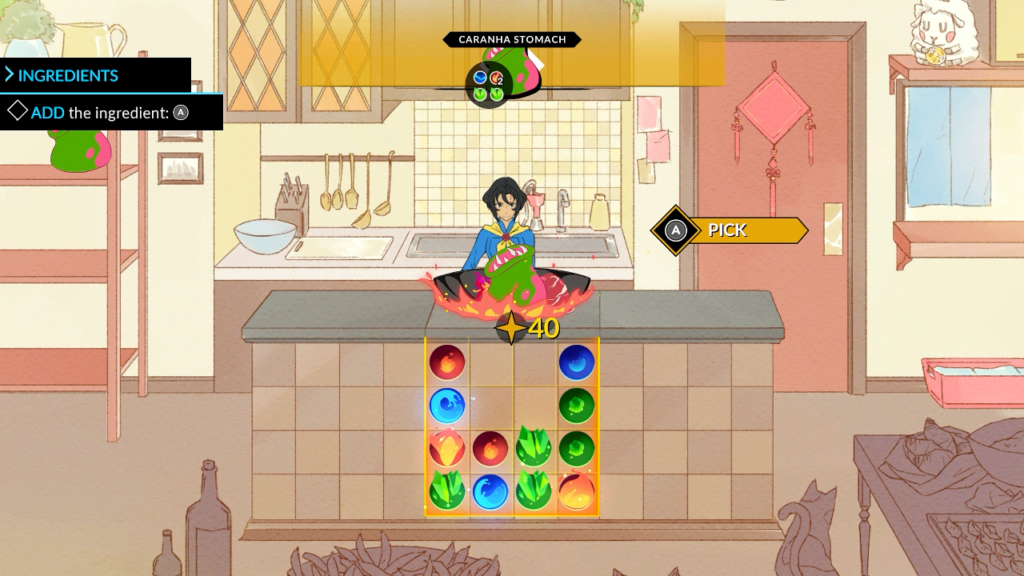
Most of Battle Chef Brigade is spent in cooking duels that take place in a magical arena. Mina travels through portals to four biomes—a forest, a cave, a mountaintop, and a cursed dark world—to hunt monsters, gather their body parts, and carry them back through the portal to prepare into a dish to present to a judge. The game style changes depending on where Mina is at. When she goes through a portal, it is a side-scrolling, monster-slashing action platformer. When she is in the arena, it is a gem-matching puzzler. I must balance both styles within a strict time limit to create a winning dish.
What qualifies as a “winning dish” changes from duel to duel. Matches are overseen by the Brigade’s Chairman Kamin, who declares a theme ingredient Mina and her opponent must include in their recipe. Early on, theme ingredients are from small monsters, like the ravenous Caranha pitcher plants or the skittering Verskit rodents. As Mina progresses through the Proving Tournament she is tasked with incorporating ingredients from deadlier monsters such as Dragons and Hydras.
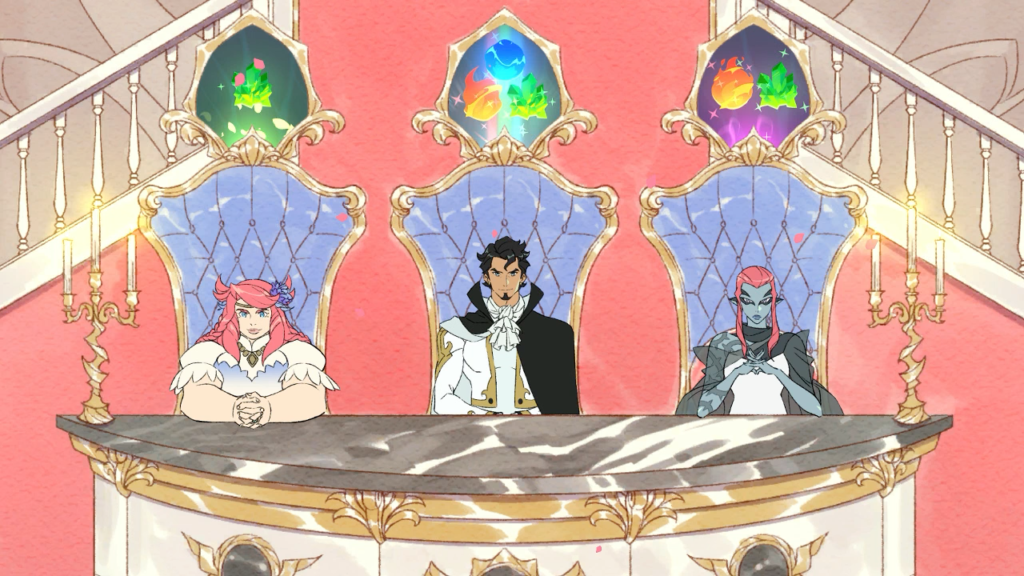
Each dish must be further tailored to the individual tastes of the duel’s judge or judges, each an experienced member of the Brigade’s diverse ranks. Ingredients are divided into elements of Fire, Water, and Earth, and Mina must honor the judge’s request for more of one element to succeed. As my skill increases and Mina’s esteem grows, judges begin to ask for a balance of two elements, or even all three in harmony.
Battle Chef Brigade’s fascinating challenge is appeasing the judges’ tastes for specific balances of Fire, Earth, and Water elements while utilizing the theme ingredient in the final dish, which sometimes clashes with requested elements.
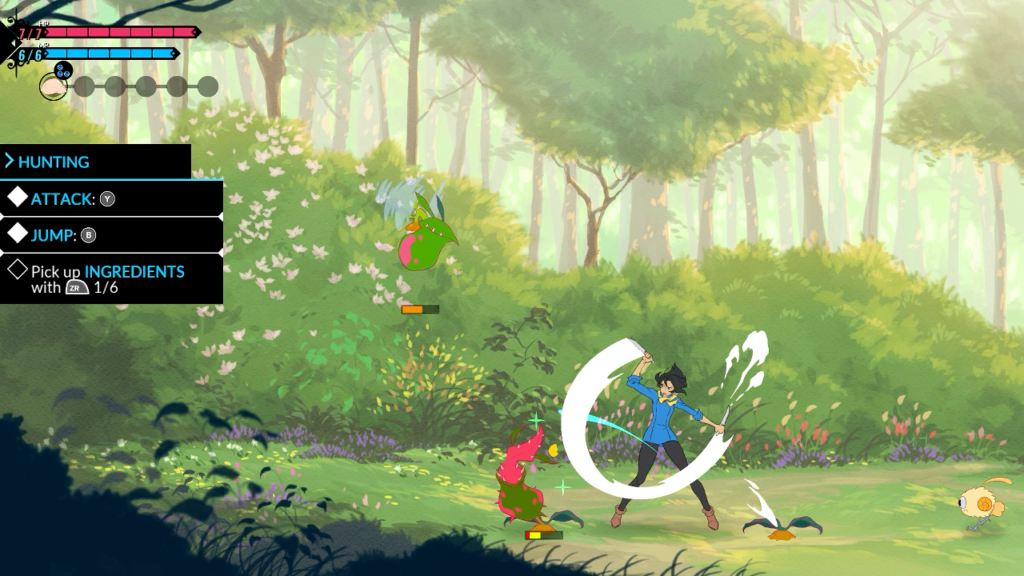
I acquire ingredients for these dishes in simple side-scrolling action arenas. Mina is an agile huntress, dual-wielding chef’s knives and employing wind magic against her quarry. Using her limited but fast-regenerating mana supplies, she can throw her knives at monsters or flash-step to strike from behind. She can also generate miniature whirlwinds to trap monsters in place or to send herself breezing past enemy attacks. Dressed in a vivid blue chef’s jacket, Mina is a Brigade exemplar: one part chef, one part ninja warrior.
Each biome offers different monsters to hunt. In the forest, Mina faces mighty Bauruns, bull-like monsters who drop thick cuts of meat, but only if Mina isn’t gored by their crooked horns first. The caves are infested by Cragmors, giant crabs who are difficult to attack without being hit by their ever-snapping claws. Armarocks are turtle-like lizards who dwell on the mountaintop, firing ice shard clusters in all directions when they sense danger then spin in their spiked shell to fend off attackers who don’t take the hint. No matter which monster I hunt, I have to skillfully avoid their attacks while efficiently draining all their hit points so I can claim the valuable ingredients they drop, all while the clock ticks away. Wasting too much time on a single monster can cost Mina the entire competition.
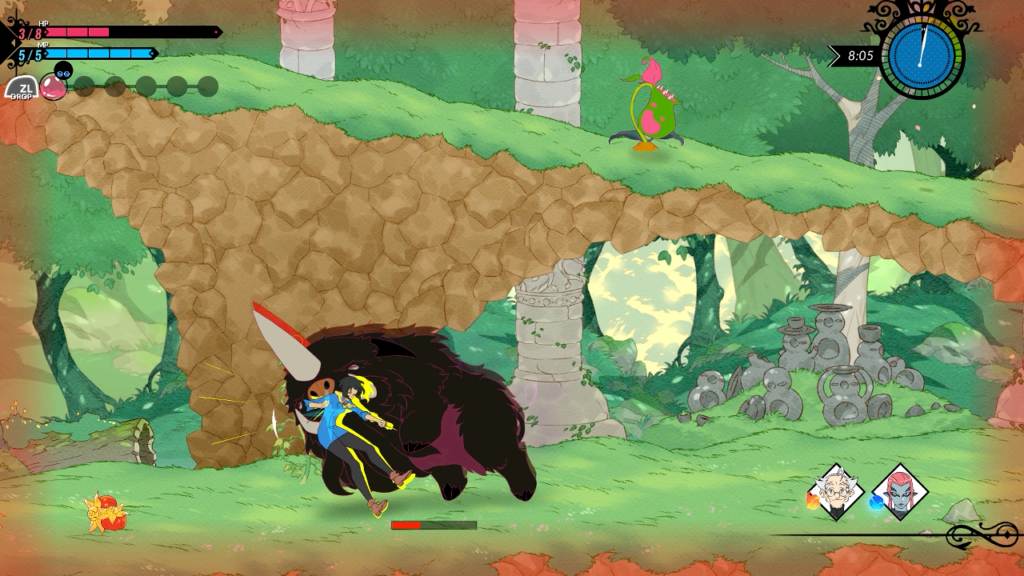
Though Mina is agile, she is also fragile. Her health meter is short and she can’t take many hits before blacking out, respawning back in the arena with restored health but penalized a portion of the duel’s remaining time. Her spinning dash ability feels meant to avoid the biggest monster’s most dangerous attacks, but I rarely use it successfully to this end since it seems to offer few, if any, invincibility frames.
When Mina does take damage, her health regenerates slowly. When I return her to the arena to cook I can count on her health recovering before I am ready to head out again, but if I make a mistake against a challenging monster—a Baurun, Armarock, or a Dragon, for instance—it often feels more prudent to restart the entire match than to expend precious time waiting for health to recover so I may challenge the monster again. These monsters’ sheer power communicates how dangerous they are and subsequently why Victusia needs the Battle Chef Brigade, but to the extent that I only deal with them when they are the duel’s theme ingredient. It’s easier, faster, and safer to otherwise focus my recipes on each biome’s vegetation and less vicious monsters.
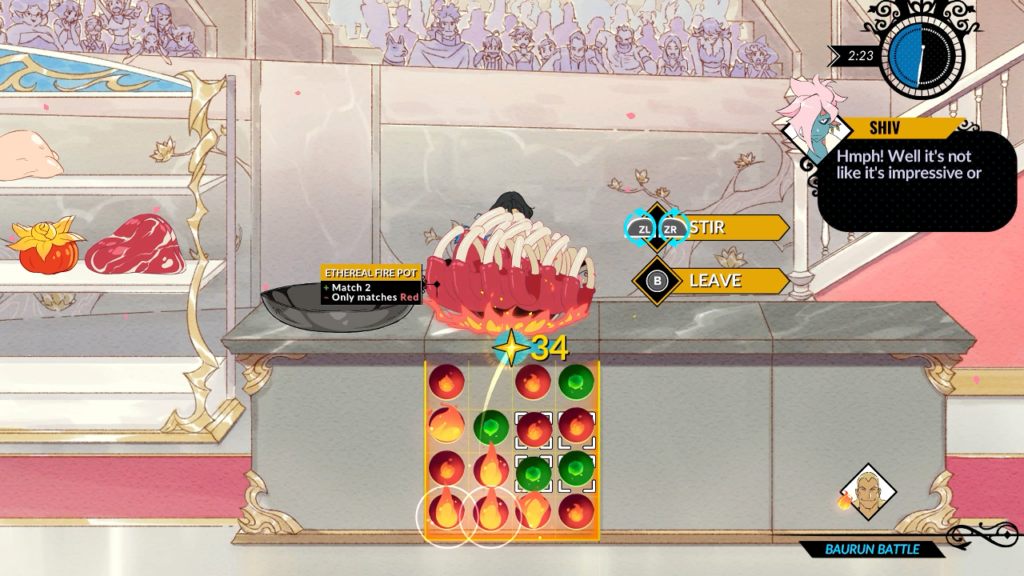
After I have filled Mina’s pockets with ingredients hunted from that duel’s biome, I return her to the central arena to cook them. This is where Battle Chef Brigade becomes a puzzle videogame. Each dish I prepare is represented by a 4×4 grid—an unusually small space for a puzzler, but I also have much more control over what will appear in that grid than the norm. As soon as Mina enters the arena, everything she carries is sorted into a pantry. When I move her to a cooking station, I can begin to drop ingredients into the puzzle grid.
Each ingredient consists of up to four differently colored gems arranged in a 2×2 block. Red gems represent Fire, blue gems represent Water, and green gems represent Earth. When I rotate gems so matching colors line up in groups of three, they combine to form a single, more valuable gem. These middle-tier gems can again be grouped in threes to create another top-tier gem. Combining gems creates room for more ingredients and also increases the point total of the overall dish. By adding ingredients that include the duel’s theme ingredient and also include gems that match each judge’s preference, I build up a prize-winning dish.
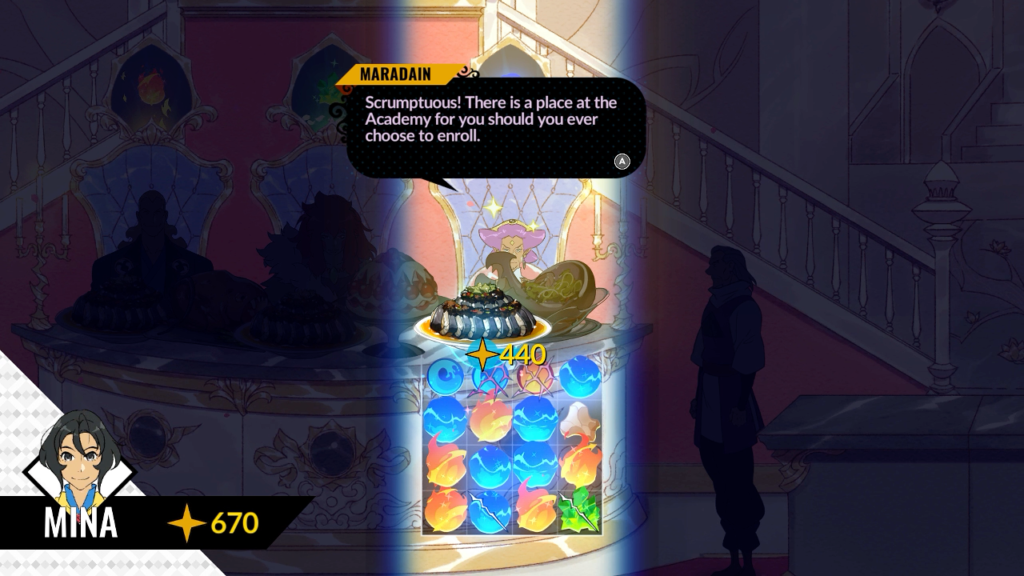
Battle Chef Brigade’s appealing gameplay loop is running through the portal to hunt ingredients in a light action videogame, then returning to prepare them in a light puzzle videogame. As my knowledge of the available ingredients in each biome grows, I can plan what I need to hunt in advance to maximize the value of my dish. If I’m competing in the forest biome and have a judge who favors Earth flavors, I learn to focus on Caranha monsters and King Bean plants, both of which carry lots of green Earth gems. In the caves, when a judge wants a mix of Fire and Water flavors, I know to mix my time between Cragmors and Lapizards. Battle Chef Brigade rewards knowledge of and experience with ingredients the way any accomplished chef is rewarded.
No self-respecting puzzle videogame would let me get away with only lining up gems in groups of three. That would be too easy. Once Mina has won her first duels, the training wheels come off and Victusia’s monsters are infected by a blight which complicates the cooking process. Some gems are made fragile and will shatter if I rotate them too much, requiring me to find efficient paths to line up three in a row. Worse still, certain monster parts have Poison in them. If I rotate Poison too much they will burst, making all the surrounding gems fragile. Worst of all, judges will deduct points from my total if I present the dish without removing the Poison first.
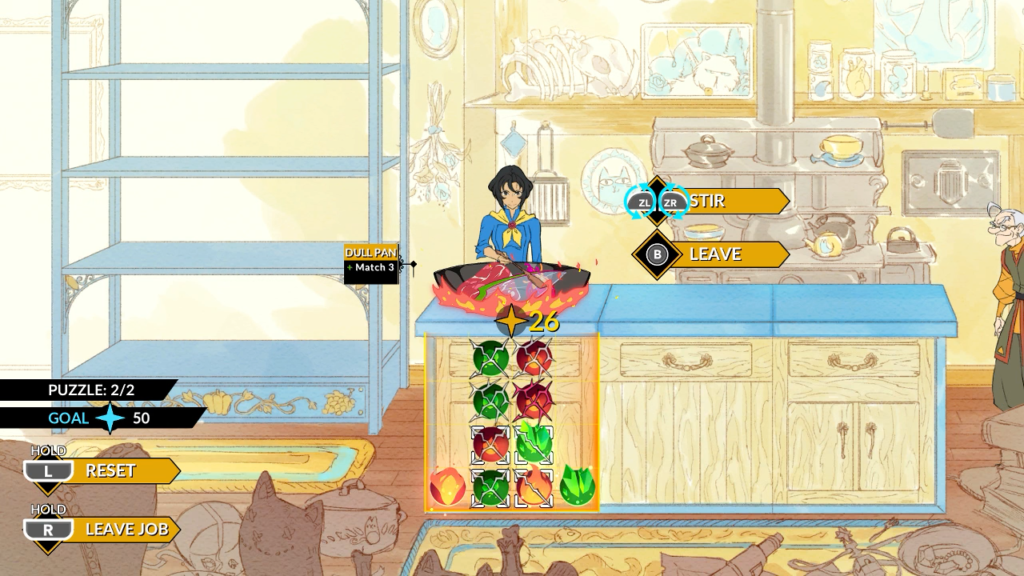
Things begin easy when I can add the gems I want and make as many haphazard rotations as I need, but as Mina progresses in the Proving Tournament I need to acquire the skill to assemble dishes with calculated efficiency to succeed.
Yet even as ingredients become more difficult to prepare, the tools available to cook with become more elaborate. Mina begins the Proving Tournament with only her trusty Dull Pan, an unremarkable tool that has no positive or negative qualities. She obtains additional cooking tools between matches. Some she receives as gifts as part of the story, others she wins from her opponents in cooking duels, and the rest can be purchased from a merchant using money earned in monster-hunting and gem-spinning minigames. But the slots Mina has available to equip these tools are limited, forcing me to make tough choices.
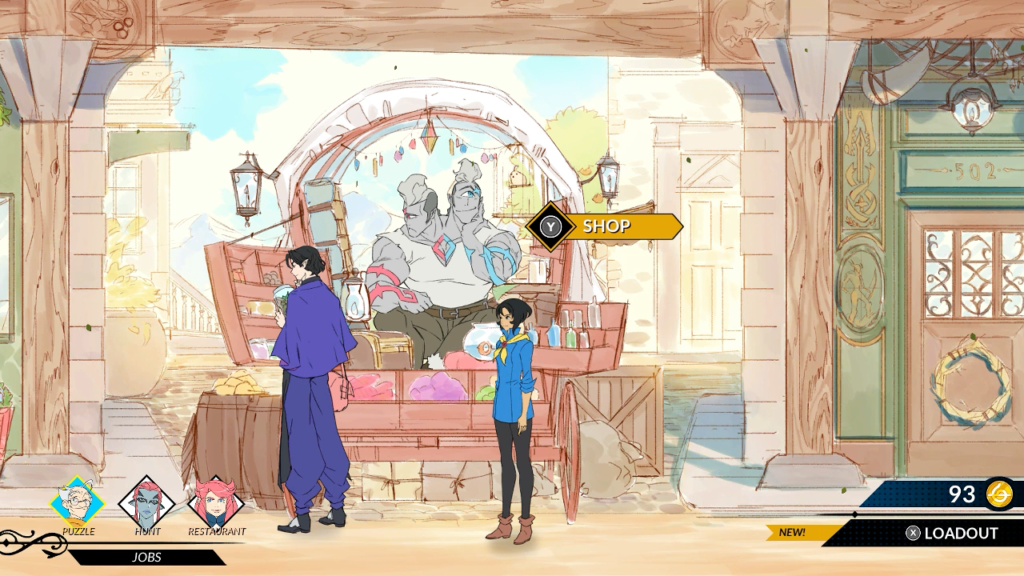
The pan or oven Mina cooks with changes how gems behave: some require fewer gems to mix; others require more gems but give greater results; still others can promote, clone, or repair gems passively when Mina steps away for more hunting. Other cooking tools provide more esoteric bonuses. Books confer Mina with expertise that earn her increased points from judges when I prepare dishes in a certain way. A beloved spatula won from a competitor lets fragile gems withstand an extra stir before shattering. An orchid blossom increases the value of gems in vegetables.
Mina can also equip tools that switch up her hunting prowess. A pair of winged boots gives her an extra jump. A bear carving from a childhood friend lets her carry more ingredients. A magic scroll increases the power and duration of her whirlwind spell. A cookie jar expands Mina’s short health bar, while an autographed photo from a rival prevents her from blacking out—but only once per duel.
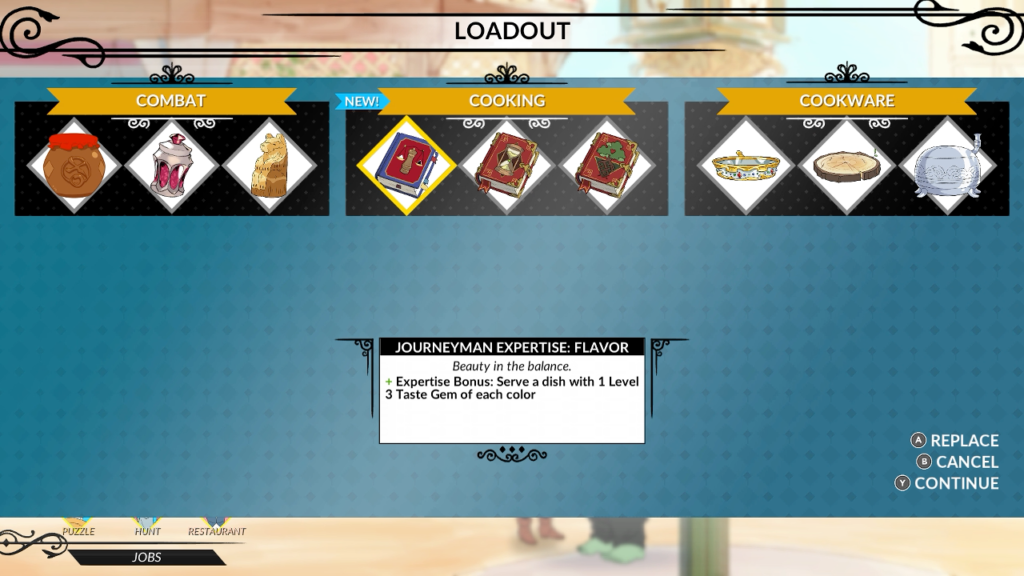
The tools I choose to use significantly customizes the type of hunting and cooking strategies I follow as the competition progresses. Every player’s Mina begins with the same loadout and relies on the same strategies to win, but by the end of Battle Chef Brigade’s 10 to 15 hour story the strategies I use will be quite different from another player’s.
As brilliantly conceived as Battle Chef Brigade’s central design mechanics are, its setting and characters are just as well-imagined. I catch only glimpses of Victusia’s breadth since the plot stays focused on Mina’s small part in the wide world, but these glimpses are tantalizing. The Proving Tournament is held in Brigade Town, whose populace and tournament participants suggest a cosmopolitan culture that co-exists peacefully despite their many differences.
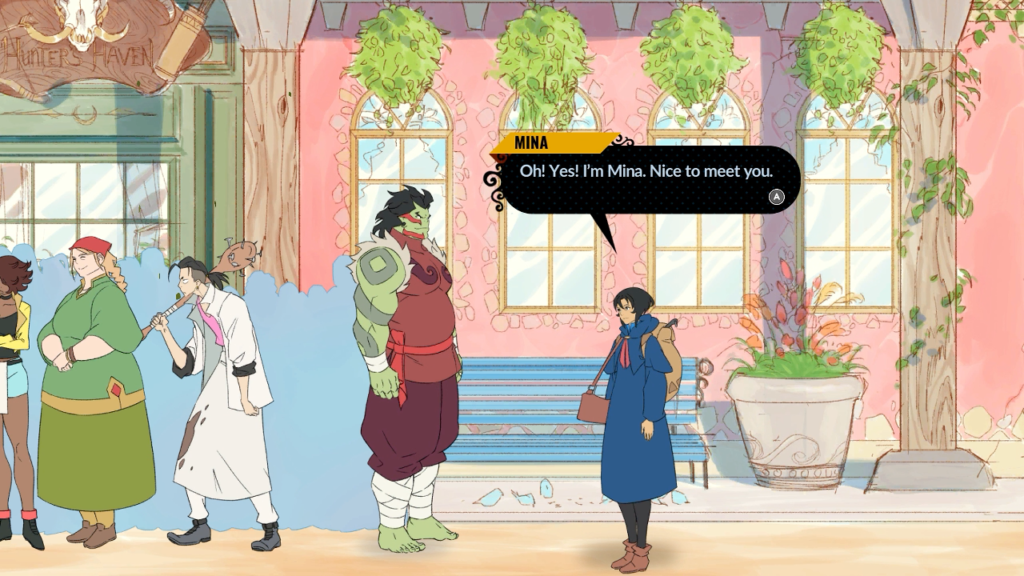
Mina makes fast friends with her fellow participants Kirin and Thrash. Kirin has an aristocratic background and seems human until she spreads her vast wings. Thrash is an orc who gives insight into a tribal and matriarchal culture in which he seems respected and at ease. This is to say nothing of the many other non-specific elves, halflings, dwarves, and goblins I glimpse in Brigade Town about whom I learn very little except that they exist. This harmony is never challenged or threatened; the hidden villain’s plot has nothing to do with breaking apart this society. It is presented as both normal and aspirational, a template for a multicultural world as it should be.
All of this aspirational multiculturalism isn’t to suggest that everybody is perfect. An orc woman named Shiv makes a strong first impression early in the competition, using her ancestry with a famous chef to antagonize her opponents. A dwarf named Cezar is taciturn and irascible, brushing off Mina’s friendly inquiries between matches. A human named Weiz uses the nickname “The Righteous Fury” in duels and has an attitude to match, holding a grudge against Mina for a bad first impression.
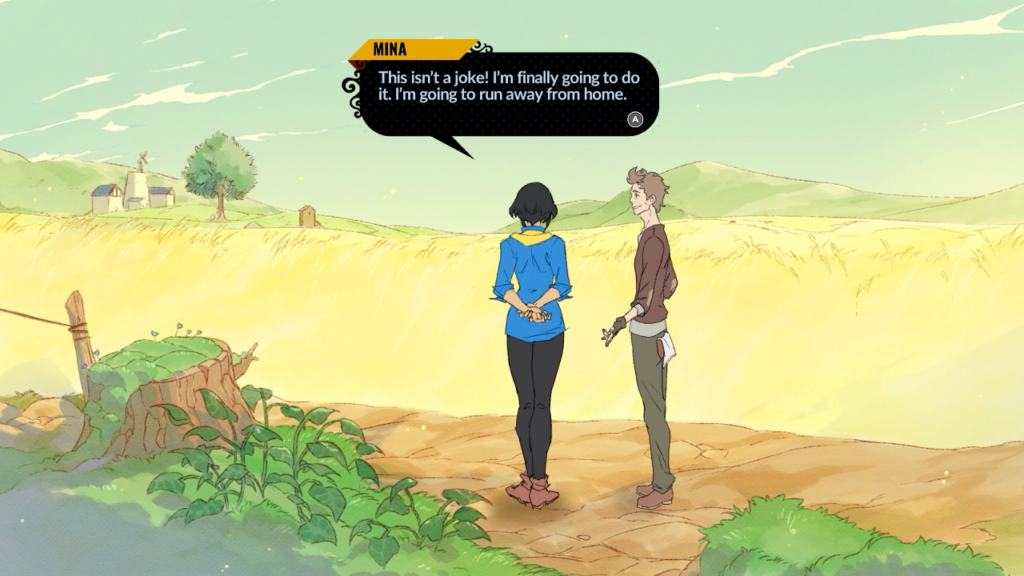
Before I meet any of these flawed characters, I meet Mina herself. To pay the entry fee for the Brigade’s Proving Tournament, she steals money from her family and sneaks off, leaving them to fill her job in their restaurant. Once in Brigade Town she cuts in front of a long line of entrants for no other reason than sheer impatience. She is prone to oversleeping—including on the first day of the tournament—and is an inattentive student. Mina isn’t a bad person, she’s just young.
But Mina grows. Through adversity and consequence and hard work, Mina changes from a brash-yet-talented chef into a principled, responsible young woman and an outstanding Brigade candidate. Her competitors also show layers and growth and rarely seem to be quite the same people they first appear to be.
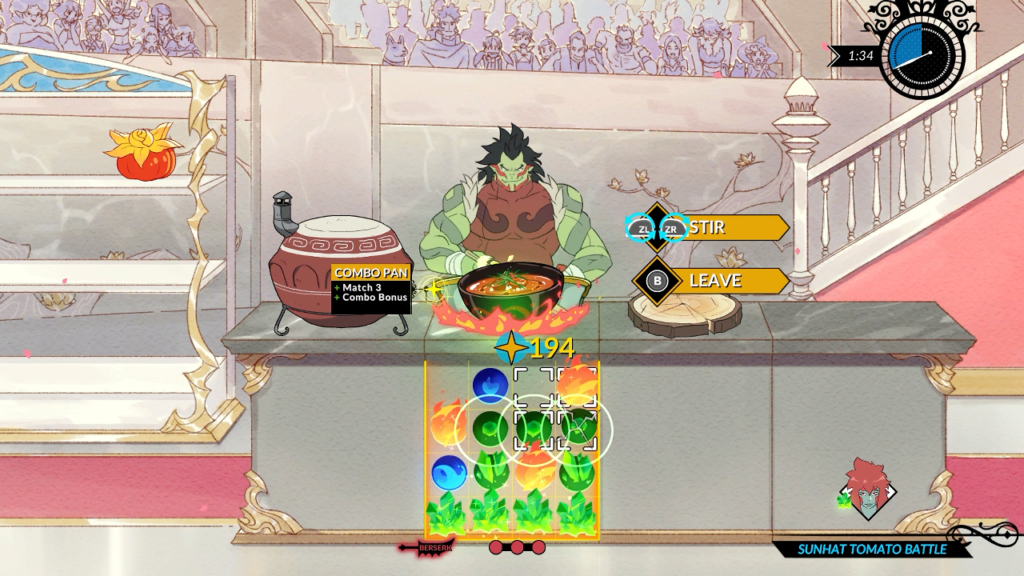
It is this attention to character where Battle Chef Brigade makes its biggest misstep. After following Mina through her highs and lows in the Proving Tournament and the cause of the Blight is about to be revealed, the entire plot grinds to a halt. I return to the story’s beginning and follow Thrash’s journey. He’s a new player character with his own fighting style and his own cooking tools. Instead of participating in the Tournament, Thrash learns that his wife has fallen ill with a deadly disease and must work with the Brigade’s research division to find a cure.
Thrash and his family are sympathetic and appealing characters. I want to help them. But his drama clashes with the central plot’s conflict, and then clashes with itself when the ingredients for the cure are stolen by an acting troupe with cockney accents. A coming-of-age story tinged with political intrigue is interrupted by a family mortality drama which is interrupted again by comic relief villains. None of it works and the few hours I spend with Thrash are the most frustrating in all of Battle Chef Brigade’s story mode.
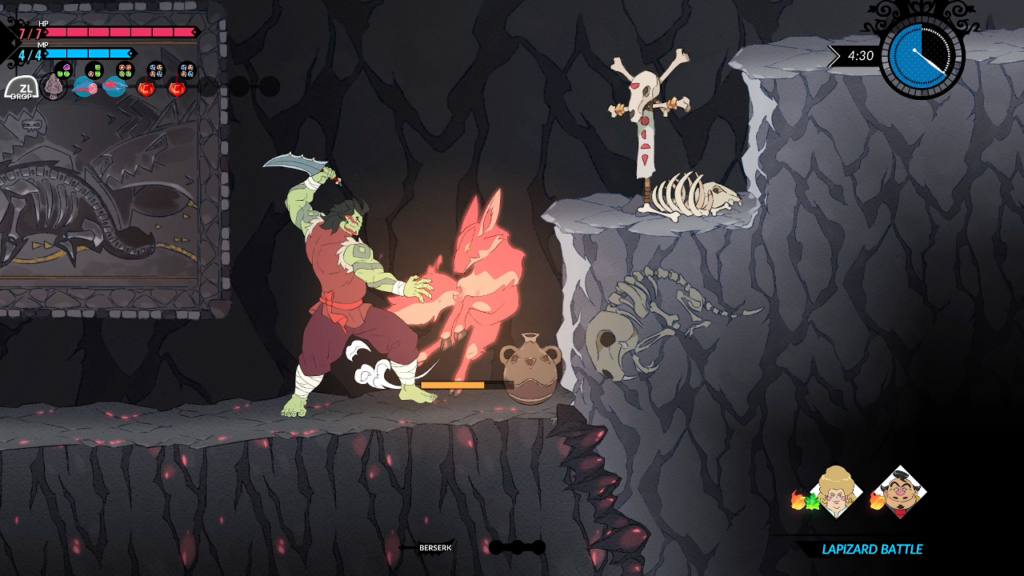
Thrash’s interlude feels like it should have been downloadable content or a side-story available post-credits. Instead it extrudes inexplicably from the main plot.
Once I have finished its story, Battle Chef Brigade still offers post-game modes to keep me participating in its inspired cooking duels. The Daily Cook-Off has me compete in duels where my final score is ranked with other players online. Sadly at the time of this writing the mode is practically dead with only a handful of other players posting scores daily. Those that do have mastered the mechanics to the point that they earn the maximum possible score every day. No compelling competition exists here.
More interesting is the Challenge Mode where I must build dishes that reach successively-higher point totals with my chef’s passive health regeneration disabled. Between rounds I can choose to heal my chef or pick a random tool to bring into future matches. I continue until my chef either runs out of hit points or I fail to reach the round’s point total in the allotted time. It’s a fantastic encapsulation of what makes Battle Chef Brigade great and ups the challenge through the roof, though it perhaps adds too much luck to the competition. If I don’t get a good cooking tool straight away, I soon find the point thresholds impossible to reach.
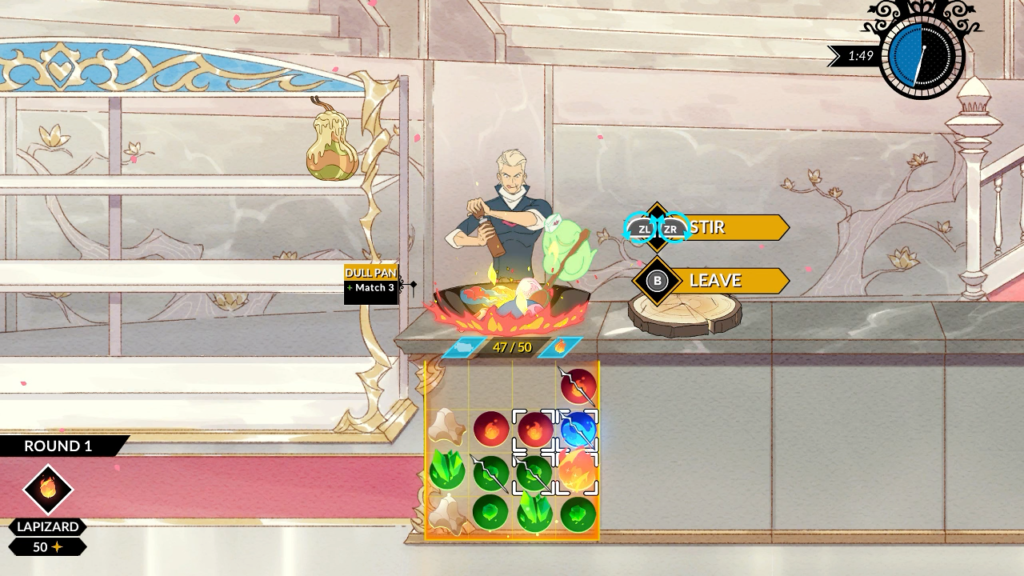
When I finish Daily Cook-Offs and Challenges I earn points that increase my Brigade Rank, unlocking concept art at specific milestones. These modes are also the only place where Ziggy is playable, a necromancer chef who can summon undead minions to help him hunt and cook. He’s too cool to ever take his hands out of his pockets so he fights with an impressive array of knees and kicks. Ziggy was added with the Deluxe update and is a glimpse at the wider roster of playable chefs first planned by the developers.
Battle Chef Brigade is a work of genius. That’s not a word I use lightly, and by it I don’t mean that Battle Chef Brigade is one of the best videogames I have ever played. I like it and recommend it, but it feels limited. The number of biomes is too few. The number of ingredients doesn’t seem to reflect the huge world suggested by the varied populace. The animation is intentionally simplistic, but can feel cheap—non-playable chefs lack a walking animation so they literally slide into the arena during their introductions, then become phantoms for the rest of the match, only reappearing during final judging when their prepared dishes seem to appear from nowhere.
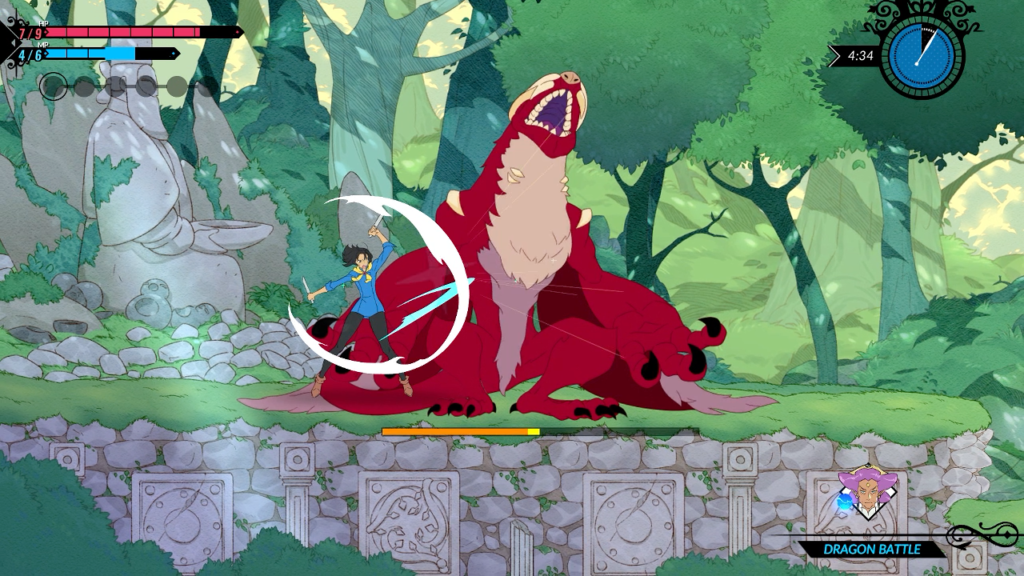
By genius, I mean Battle Chef Brigade is inspired. Its gameplay loop of hunting in an action platformer and cooking in a gem-spinning puzzler is something I’ve never seen before. In a market saturated with videogames chasing after the latest fad, it’s refreshing to play something so wholly unconcerned with what’s selling well for other studios. It’s a great videogame with the shine of something much more. If Trinket Studios ever makes a sequel that refines and expands on what they’ve created here, they can count on me to be first in line. I fervently believe it will be an all-time classic. As for Battle Chef Brigade, it will have to settle for being brilliant, unique, and flawed.